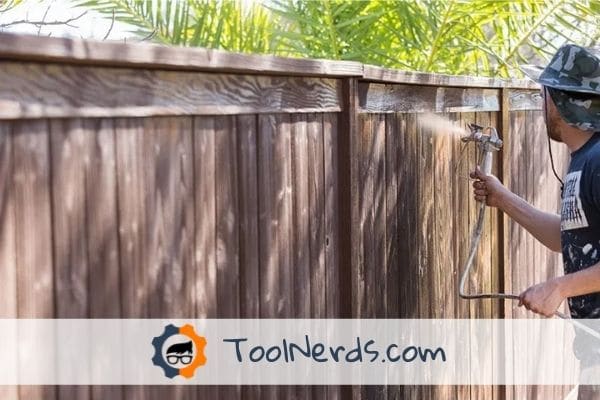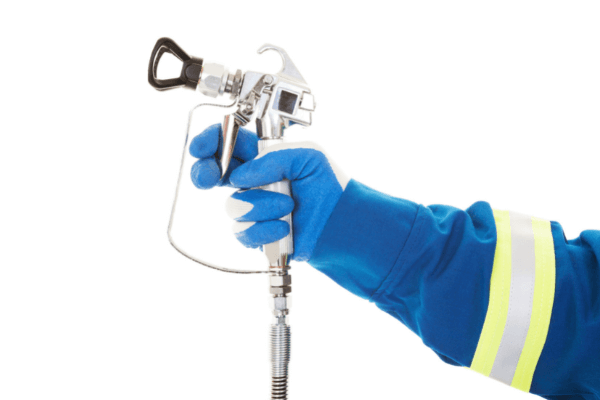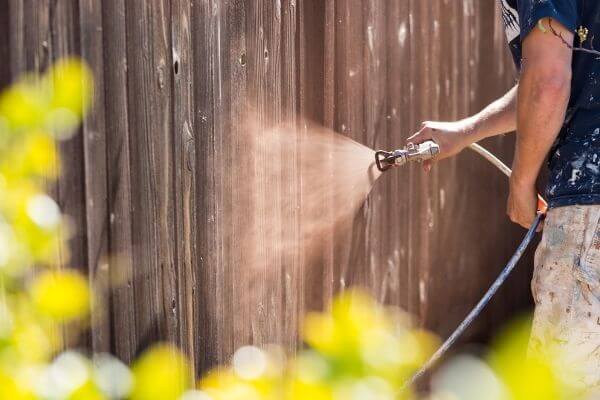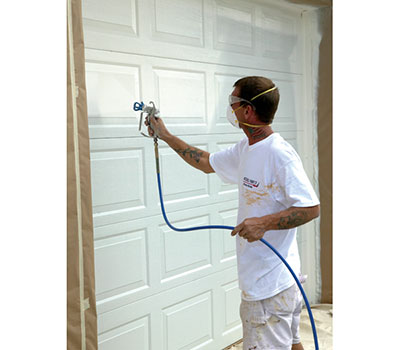
Comparing Paint Sprayers
Airless machines aren’t the only sprayers on the market. If you’re looking to buy a power painter, you have three options — pneumatic, HVLP turbine, and airless.
The ideal unit depends on the scale of your project, the type of paint you’re utilizing, the finish you require, and your budget.
Here’s a quick comparison:
Pneumatic
-
- Requires a separate compressor to drive the spray gun.
- Finest finish and control in the whole spray painting category.
- Louder than all other formats.
- Can interchange standard, HVLP (high-volume low-pressure), and LVLP (low-volume low-pressure) guns.
- Multi-medium compatible.
- The compressor requirement makes them difficult to transport.
For more information, check out my ultimate guide to pneumatic sprayers.
HVLP Turbine
-
- Most affordable of all the paint spraying machines.
- Available in handheld and external-drive models.
- Low paint wastage.
- Lightweight.
- Straightforward operation — ideal for spraying newbies.
- Depending on the model, can deliver all paint densities.
- Most machines have adjustable turbine power output.
- Safe operation due to low power delivery.
- Excellent small-to-medium project format.
If you want to learn more about these machines, take a look at my HVLP Turbine 101 article.
Airless
-
- Highest pressure output in the entire spray painting category.
- Ultra-fast coverage.
- Fine atomization.
- Can deliver the densest mediums — epoxies, elastomerics, and roof coatings.
- Liable to overspray and wastage.
- Care needs to be taken due to high power output.
- Excellent for massive projects.
- Some units can handle multiple guns.
- Require significant prep and maintenance.
For the ultimate machines in this category, check out my guide to the Best Airless Sprayers.
How An Airless Paint Sprayer Works

The Technique
While within the capabilities of most DIYers — airless machines are the most complex sprayers to operate in the power painting category.
This is due to:
-
- Incredibly high-pressure output.
- The requirement to prime before use.
- Selecting the optimum pressure to suit the coating medium.
- High-risk of wastage and overspray.
- Hydraulic pumps require maintenance and TLC.
- Need to utilize the correct nozzle tip.
That said, once up and running, you wield an airless machine in the same way as you would any power painter:
-
- Use side-to-side or up-and-down movements.
- Utilize long strokes.
- Overlap each pass by 30-50 percent.
- Select the correct spray pattern — horizontal, vertical, or circular.
- Spray from a distance of 8-12 inches.
- Avoid coating recently dried paint with wet.
As airless machines can be challenging to set up, especially for the newbie user, check out my Guide to Operating an Airless Sprayer.
Choosing The Right Sprayer

Looking online for a new sprayer? You’ll need the right combo of specifications for a successful project. As a shortcut, you can jump straight over to my Top Airless Sprayers rundown — alternatively, here are the factors you should take into consideration when picking out your ultimate machine.
External Drive or Handheld
For those smaller projects, a handheld airless sprayer is the consummate machine.
They need less prep time than their external drive cousins and are highly portable — no larger than a standard hammer drill. Delivering around 1500 PSI, they’re capable of speedy coverage and dense medium compatibility — although their use is restricted by the size of the paint container. Furthermore, by housing the hydraulic pump in the gun itself — they are seriously weighty units.
External drives house the pump section in either a floor-standing or cart-mounted casing. While reducing the transportability somewhat, it allows for a beefier motor and a lightweight gun — increasing the speed of coverage. Furthermore, they typically draw the coating medium directly from an original can — meaning no refilling.
Power Output
More grunt means speedier coverage and a finer mist of paint.
What’s more, the beefier the machine, the more capable it is of knocking out dense mediums — check out my Guide on Paint for more info on relative paint viscosities.
Project Size
The size of your project will affect how powerful a sprayer you need. Bigger jobs, such as fence staining, will need more pressure and horsepower — while smaller work, like cabinet refinishing, may only require a handheld unit such as the Graco 17M359.
Cord and Hose Length
Length is important. The longer your hose and cord, the further away you can operate from mains outlets. And, for external-drive airless machines, the less frequently you need to move the power unit. That said, bear in mind that if these components are excessively lengthy — they can be an encumbrance by becoming a tripping risk. There are a few cordless airless machines on the market — such as the Ultra 17M363 — but due to the high power demands on the lithium cells, running times can be low. A quick tip. In addition to looking at the relative sizes of hoses and cords, I recommend also investigating the maximum length of hose that the sprayer can support. For example, the impressive 210ES includes a 50-foot hose, yet it can handle up to 200 feet. Hence, you can later step up to a lengthier hose without impeding the performance of your unit.Volume Capability
Often measured in weekly or annual throughput, generally speaking, the volume capability indicates how durable your machine is. That is, whether it’s rated for casual and intermittent DIY use — or hardcore daily professional applications. Trade users should seek out one of the best professional machines, such as the Titan 440 Impact, which can handle around 100 gallons per week throughput.Use The Right Tips
The tip is where the spraying magic happens — it determines the width of the spray fan, delivery intensity, and level of atomization. That said, because of the mighty 3000 PSI-plus output of most airless units, they can knock out thick paints with a remarkably small tip size. The sizes are usually explained by three numbers — for example, the 517, which is the most commonly used nozzle in airless machines. The initial number (5) explains the fan spray radius, hence it’s five inches, or ten inches in diameter. The following two numbers (17) denote the tip diameter in one-thousandths-of-an-inch — so, 0.017 inches. For mammoth jobs, typically you utilize a generous spray width — like 517, 617, or 717. And on precise finishing work, a more modest tip, like 217 or 317. It’s worth checking whether your machine comes with a choice of more than one tip, such as the Himalaya. If not, the larger brands of Graco, Titan, and Wagner offer a wide catalog of additional nozzles ends. As selecting tips for airless sprayers can be a little confusing at first, I’ve put together a complete 101 on Choosing the Right Nozzle for Your Airless Sprayer.
Number Of Guns
For smaller and medium jobs at home, one paint gun will get your job done. But for larger commercial and industrial projects, you’ll need a crew. So buy several guns to accommodate everyone — and ensure your unit can handle more than one shooter, like the Graco GH230.Filters
If you’re looking for a smooth finish on your job, and you want to protect your unit’s internal components — ensure it incorporates filters. At the very minimum, you’re looking for these protective meshes included in the gun itself, and on the suction hose — ensuring that paint debris and detritus don’t impede use. They prevent your tips from clogging up — which can lead to splattering paint and wasted downtime.Conditioners & Protectants
You can extend the life of your paint sprayer by applying formulas. Conditioners and pump protectants shield your sprayer from freezing, rust, and other hazards.
A Few More Pointers…
In addition to the above features, other factors you may consider include:
-
- Cart or stand-mounted.
- Ease of disassembly — allowing for fuss-free post-project cleaning.
- Level of pressure control — the more steps, the more user-customizable the sprayer.
- Availability of spare parts — choosing a respected brand guarantees access to replacement components.
- Spray fan width — larger promotes more rapid coverage.
- Included accessories — such as brushes, wrenches, and tips.
- Straightforward maintenance — some units allow speedy pump exchange without tools.
- Warranty length.
Costs of Airless Sprayers
Airless sprayers run from a few hundred dollars through to the high thousands — depending on the brand, power output, durability, and throughput rating.
You can pick up a high-quality, prosumer unit such as the HomeRight Power Flo Pro 2800 for the price of a good night out — while at the contractor end, a mighty machine such as the Graco GH230 will set you back the price of a family vacation.
The key is choosing a product that’s within your budget but meets the demands of your current and future projects. Check out my Budget Machines rundown.
Safety

-
- Always wear gloves — the jet from an airless sprayer can penetrate your skin, known as an injection injury — leading to paint toxins entering your body. Should this occur, seek medical attention immediately.
- Don protective goggles — not just to shield your eyes from the paint plume, but also from bounceback.
- Put on a face mask — fumes and atomized spray can enter your lungs.
- Always spray in a well-ventilated area — open windows, doors, louvers, and use additional fans if necessary.
- Read the manufacturer’s instruction guide before first use.
- Take your time — most accidents occur due to haste.
- Cover everything in the area of your project, including plants and windows with drop cloths.
- Don’t paint on windy days.
When You Shouldn’t Use An Airless Paint Sprayer
Although airless sprayers are useful tools, there are some downsides.
- Hydraulic machines can deliver high overspray, bounceback, and mess.
- The high-power output of airless machines can lead to wastage, increasing the costs of your job — choose a high-efficiency airless machine such as the Wagner Control Pro 170.
- Hydraulic painters require prep and priming before use.
- Safety — care needs to be taken due to the high-pressure delivery.
- Only suitable for large jobs — massive grunt, set-up time, and immense volume delivery makes them overkill for small projects — just use a brush or a handheld turbine instead.
- Maintenance — airless units need some TLC to stay in top condition. If you encounter any issues, check out my Airless troubleshooting guide.
Conclusion
Airless sprayers are the ultimate painting machines for home-improvers and trade contractors wanting to take on larger-scale jobs.
Knocking out coating mediums more rapidly than pneumatics and turbines, these units excel at addressing walls, sheds, fencings, deckings, outbuildings, and ceilings.
The niche is expansive, including budget models, handhelds, prosumer units, contractor-grade machines, and multi-user contractor examples. For the top models in each category, check out my Best Airless Sprayers Guide.
I hope that you’ve enjoyed this easy guide to buying an airless paint sprayer — and, if you think any of your buddies would be interested, please feel free to share.










